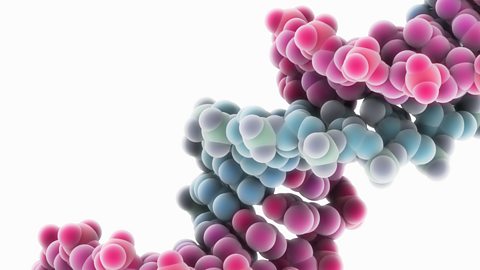A food chain shows how plants and animals get their energy.
Ecosystems
Here is an example of an ecosystem that might exist around an oak tree.
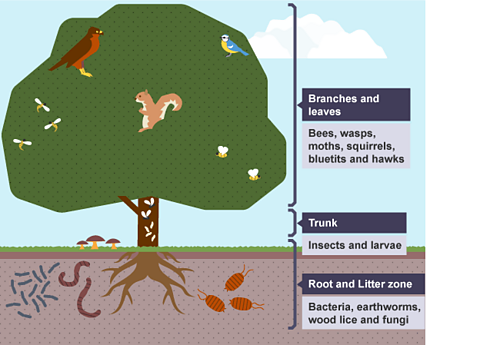
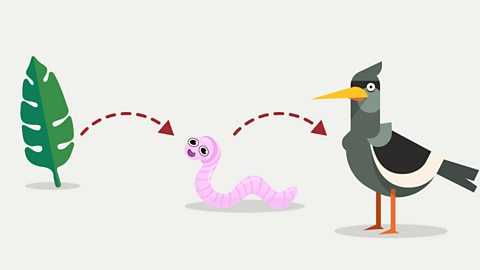
This food chain shows
- a leaf
- eaten by a worm
- which is then eaten by a bird.
leaf  worm  bird
The arrow means 'is eaten by' and shows the movement of energy in the food chain.
The initial source of energy for all food chains is the sun.
Producers and consumers
A food chain always starts with a producer. A producer is an organism that makes its own food. Most food chains start with a green plant, because plants make their own food by photosynthesis.
A consumer is a living thing that eats other plants and animals.
Food chain basics:
- First, a producer ÔÇô a plant that makes its own food from sunlight.
- Next, a consumer that eats the producer.
- Then, another consumer that eats the first consumer
Here is an example of a simple food chain:
grass  cow  human
The grass is the producer. The cow and human are consumers.
A food chain is a list of organisms in a habitatThe place where an organism lives. that shows their feeding relationship, i.e what eats what. The organisms are joined by arrows which show the transfer of energy in food between them. The stages in food chains are called trophic levels.
Predators and prey
A predator is an animal that eats other animals.
Prey are the animals that predators eat.
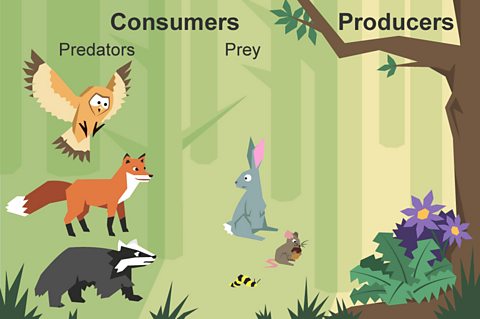
Predators are found at the top of a food chain.
- A fox is a predator, and a rabbit is its prey
- An owl is a predator, and a mouse is its prey
An animal is often both a predator and prey
- a frog is a predator, and a grasshopper is its prey
- a hawk is a predator, and a frog is its prey

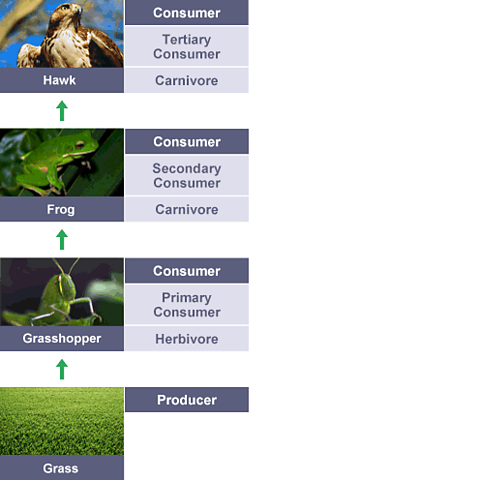
Remember:
- A herbivore is an animal that only eats plants
- An omnivore eats plants and animals
- A carnivore only eats animals
- An insectivore eats some animals such as insects and worms
grass  grasshopper  frog  hawk
The grass is the producer, and the animals are consumers:
The first consumer in the chain is also called the primary consumer
The next one is the secondary consumer
The one after that is the tertiary consumer

Pyramids of numbers
The population or number of each organism in a food chain can be shown in a special type of bar chart called a pyramid of numbers. The bars are all the same height and are drawn to scale ÔÇô the more organisms it represents, the wider the bar. The producer in the food chain always goes at the bottom of the pyramid of numbers.
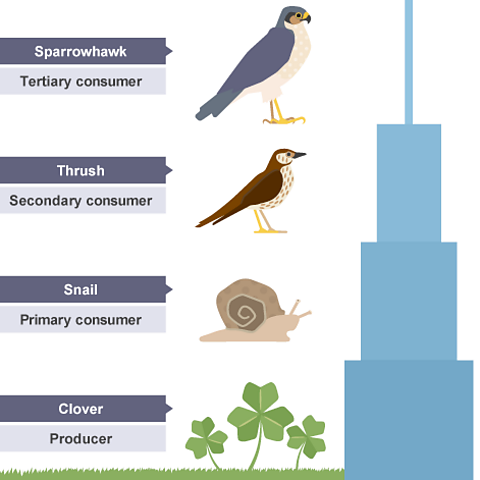
Think about this food chain:
clover  snail  thrush  hawk
Clover is a plant and it is the producer in this food chain. Its bar goes at the bottom of the pyramid.
Energy is lost to the surroundings as we go from one level to the next, so there are usually fewer organisms at each level in this food chain.
A lot of clover is needed to support the snail population. Each thrush eats lots of snails, and each hawk eats lots of thrushes, so the number of hawks is very small.
Other pyramid shapes
Sometimes the pyramid of numbers does not look like a pyramid at all! This could happen if the producer is a large plant such as a tree, or if one of the animals is very small. Remember that the producer always goes at the bottom of the pyramid.
Here are two examples of this:

An oak tree is very large so many insects can feed on it
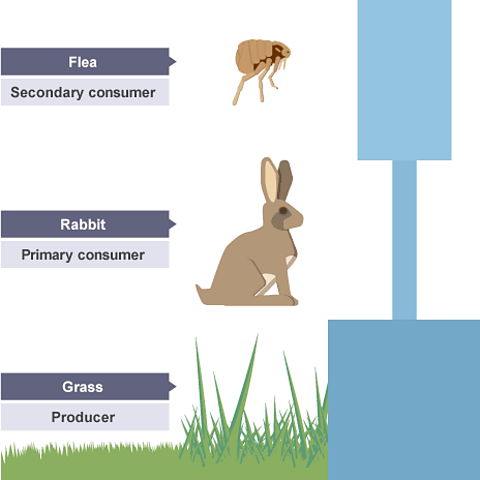
Fleas are very small so lots of them can feed on a rabbit
Food chain summary
- The initial source of energy for all food chains is the sun
- A food chain always starts with a producer ÔÇô usually a green plant
- A producer is a plant that makes its own food from sunlight
- Next comes a consumer that eats the producer
- A consumer is a living thing that eats other plants and animals.
- The arrows in a food chain show the way in which energy is moving.
- A predator is an animal that eats other animals.
- Prey are the animals that predators eat.
Food Webs
A food web is made up of a number of food chains. It shows all the food chains in an ecosystem. Here is an example of a food web:
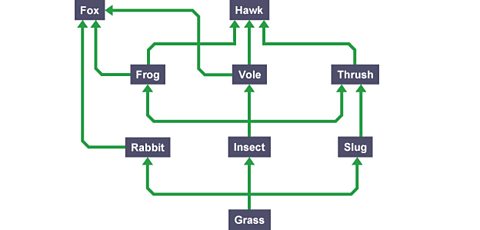
Although it looks complex, it is just several food chains joined together. Here are some of the food chains in this food web:
grass  insect  vole  hawk
grass  insect  frog  fox
grass  insect  vole  fox
grass  rabbit  fox
Notice that:
- the rabbits and slugs have just one predator
- the frogs and voles have two predators (foxes and hawks)
- the insects have three predators (frogs, voles and thrushes)
This leads to some interesting effects if the population or number of a particular organism in the food web decreases. Some animals can just eat more of another organism if food is in short supply, while others may starve and die. This in turn can affect the populations of other organisms in the food web.
Changes to food webs
What would happen if the population of one of the organisms changed?
What would happen if the grass died?
- The grass is the producer
- Rabbits, insects and slugs would have no food
- They would starve and die unless they could move to another area
- All the other animals in the food web would die too, because their food supplies would have gone.
What would happen if the population of slugs decreased?
- Slugs, rabbits and insects all eat grass.
- If there were fewer slugs there would be more grass for the rabbits and insects to eat.
- With more food, the populations of rabbits and insects would increase.
- However, the thrushes who eat both insects and slugs would have to eat more insects to maintain their population, so it is also possible that the population of insects could decrease.
- This in turn may reduce the populations of voles and frogs.
Food security
All the food we eat relies on plants. This includes meat because animals such as pigs, sheep and cattle eat plants. Grasses such as wheat, barley and rice use the wind for pollination. Vegetables and plants that produce fruit rely on insects and other animals for their pollination. If the population of pollinating insects goes down, it reduces the amount of fruit for us to eat, and also the number of seeds for new crop plants to grow.
Toxic materials in the food chain
Toxic materials are poisonous. Some quickly break down into harmless substances in the environment.
Others are persistent (they stay in the environment and do not break down). These substances accumulate in the food chain and damage the organisms in it, particularly in the predators at the end of the chain. This is because the accumulating compounds cannot be excreted.
Mercury
Mercury compounds were used until recently to make insecticides (substances that kill the insects that damage crops), and special paints that stop barnacles growing on the hulls of ships.
Unfortunately, when mercury gets into a food chain, it damages the nervous systems and reproductive systems of mammals, including humans. The diagram shows how mercury can accumulate in the food chain.

In the sea, tiny animals and plants called plankton absorb the mercury compounds. When the plankton are eaten by small fish, the mercury they contain stays in the fish. As the fish need to eat a lot of plankton, the concentration of mercury in them becomes higher than its concentration in the plankton.
Larger fish eat the small fish, and larger ones still (such as tuna fish) eat them. This creates a high concentration of mercury in the tuna. This is called bioaccumulation. People eating contaminated tuna may get mercury poisoning. Mercury is now banned from many chemical products and mercury use in industry is carefully regulated.
DDT
DDT is an insecticide that can pass up the food chain from insects to small birds, and then from the small birds to birds of prey, like hawks. It can accumulate in the birds of prey, giving them a large amount of DDT. High concentrations of DDT in birds cause weakness in the shells of their eggs, which leads to a reduction in their population. DDT is now banned because of this.
Test your knowledge
More on Biology
Find out more by working through a topic
- count2 of 11

- count3 of 11

- count4 of 11

- count5 of 11
